Pattern and instructions
Tunic and Pants
Tunic
First you need to decide what style it is going to be:
- Long or short sleeved;
- plain or decorated;
- splits in the side, front or none at all
1
Once you have decided on the style, fold your material in half to the desired length, then fold it in half selvage to selvage. (A selvage is the finished edge of the fabric.) Measure your torso and find the largest measurement, either your hips or your chest, and divide by four. As your material is already divided into quarters, you only need one quarter of the total measurement. This is the minimum width your tunic must be from the centre fold if you want it to fit.
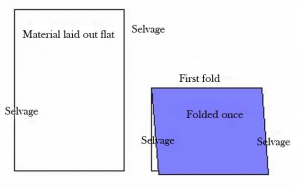
2
Draw your pattern onto the material. Note: If you do not have splits in your tunic cut more flare in your pattern so you can move without tearing the fabric. Cut out the pattern and also cut a small hole for the neck. If you are adding extra length to your sleeves cut that out now from the extra fabric you bought!
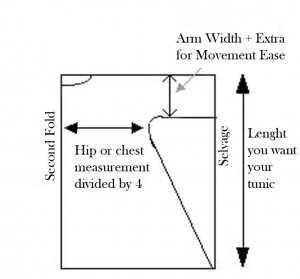
3
Decide on the shape of your neckline and cut this out. (Note: Opening must be big enough to fit over your head! Measure around your head remembering that your ears stick out more than your forehead!! Keyhole necklines can be cut smaller as the split allows extra room.) Always cut out less rather than more.
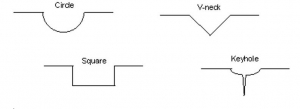
4
Once the neck hole is cut, open up the tunic and lay it out flat, then take a piece of scrap material (which can be of a different colour) that is slightly larger than the neck shape (at least 2″ all around). This will become your neck facing. Lay the facing fabric over the neck hole with right sides together and pin it down. (At this point I find it helps to draw the neck line shape on the facing so it will be neater when you sew.)
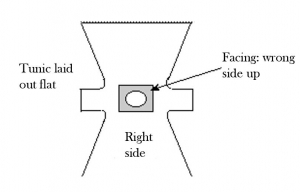
5
Sew around the neckline. Lay the tunic out flat again and cut out the material in the middle of the neck hole about 1cm away from the stitching leaving an even seam. Remember to clip any right angles and curves as this lets the material sit properly when turned the right way.
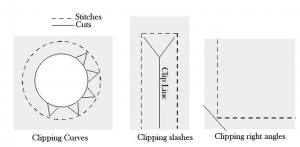
6
Neaten up the facing edge and finish the outer edge (zig-zag or overlock will do) and turn the facing to the inside of the tunic. Iron the facing flat then pin down and sew around again. This keeps the facing in place.

7
If you are adding extra length to the sleeves, sew the additional piece onto the end of the tunic sleeve. Add any decorations or braid to the sleeves and neck now, taking care to match the ends at the seams. If the sleeves are going to be tight hem them now, if you are having loose sleeves, leave the hemming until last.
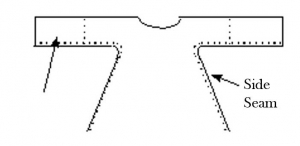
8
If the tunic has no splits, pin the side seams with the right sides together and sew them up. Hem the sleeves (if not already done) and the bottom edge and your tunic is finished.
9
If your tunic is to have side splits, pin the side seams together to where you want the splits to start. Sew the seams up to this point, then hem the side splits, the bottom and the sleeves.
10
If you want front and back splits it will take a bit longer. Before sewing up the side seams, put on the tunic and get someone to cut the front split as high as you want it. Lay out the tunic and cut the back seam to the same length. To make facings for the split get 2 pieces of fabric which are slightly longer than the split and about 3″ wide. Keeping the split together, centre the facing over the split and pin it to your tunic. Sew around the split cut, remove the pins and cut the facing up the split line. Finish the outer edges of the facing (overlock or zig-zag stitch), and turn to the inside of the tunic. If you have sewn a square around the top of the slit, you will need to clip the seam before turning it (refer to figure at point 5 above). Iron flat, pin down and sew around to hold in place. Sew up the side seams and the bottom edge then decorate the hem line if you wish.

Pants
Pants can range from hugely baggy through to stovepipes and everything in between. Decide what type of pants you want.
1
Get your material and fold it lengthways slightly longer than the desired pants length, then fold it selvage to selvage and lay it out on a flat surface.
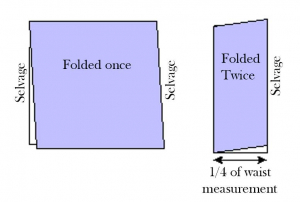
2
Get a tape measure and measure from the front waistband of the trousers you are wearing to the back waistband putting the tape measure between your legs. Don’t hold the measure too tight! Try sitting down with the tape measure between your legs to check the groin curve. This measurement will stop you making your pants too tight in the crotch (you need room for movement). From the centre fold in the fabric, measure inwards about 7cm and then measure down half your groin measurement adding a curve back towards the centreline.

3
If you only want slightly baggy pants measure around your waist and add a little extra for seams and movement (about 3 – 4 inches if you are doing ½ inch seams; this allows 2 inches ease). Divide your adjusted waist measurement by 4 and measure this distance from the groin line at the waist and mark. If you want a tapered leg draw an angled line from the end of the groin curve to the bottom of the pants, and a line from the waist mark to the hem line leaving enough between the two so your leg will fit. (This measurement should be slightly bigger than half your leg size.)
If you want baggy pants, add the extra onto your waist measurement and proceed as above.
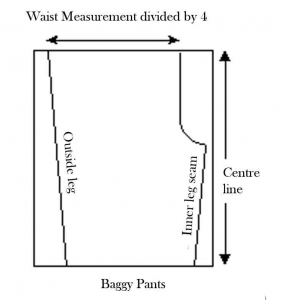
4
Once your pattern is drawn cut out. Take 2 pieces and with right sides together pin the groin curve seams and sew up. Do the same with the other two pieces. With right sides together, pin the outer seams together and sew. Finally pin the inner leg seams together and sew. Hem the bottom and put a waistband on the top for a drawstring or elastic. You can also put elastic in the bottoms or leave them to tuck into your boots.


